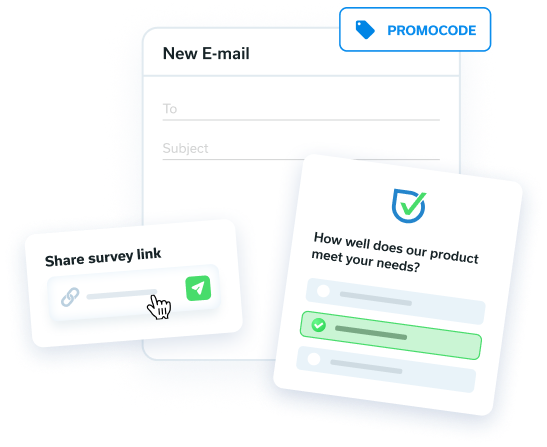How to Get Quality Customer Feedback: 15 Best Ways


Quality customer feedback is one of the most effective ways to improve customer experience, reduce churn, and boost your business growth.
What’s more, without understanding your clients’ opinions about your product and service, you can’t create a truly customer-centric business and provide the best experience both for prospects and clients.
However, not every company streamlines the process of collecting customer feedback.
The reason is quite simple: it’s difficult.
Clients don’t hurry up to provide you with valuable information and response rates are low. Unless the experience is really awful, people usually don’t bother to share their testimonials.
To address this challenge, businesses have invented an ocean of more or less successful ways to engage customers and seek responses.
We have listed 15 different methods using which you can collect high-quality customer feedback.
1. Get feedback with the help of live chat support
Website visitors like live chats because this type of software solves a bunch of questions about availability, payment, shipping, etc.
Besides a better understanding of prospects’ needs and challenges, live chats identify recurring issues and find long-term solutions for businesses.


Drift’s live chat software
When it comes to acquiring customer feedback, live chats are crucial as well.
You can ask for any type of feedback during support sessions.
In addition, seek service feedback after a chat session ends with basic questions like ‘Was the chat experience helpful? ’ Doing so, you’ll be able to rate the effectiveness of your live IT support process.
Pro Tip: Increase the efficiency of your online chat by making it proactive. Set the chat window to appear at a given time, for example, when a prospect has been reading a website page for 25 seconds.
2. Insert customer feedback forms of all types
First of all, locate a dedicated feedback email (feedback@yourcompany.com) on the highly visible place on your website.
What’s more, you can provide a short dedicated feedback form that includes all the needed questions.
Another type of website customer feedback form is targeted surveys. With the help of advanced targeting options like percentage of the scroll, exit intent, time on site, etc.), targeted surveys can appear exactly when and where they need to be.


Mopinion’s feedback form template
What it’ll be – radio boxes, checkboxes, text fields, smiley faces – depends on your marketing and business needs. They can be presented as a static button or pop-up widget.
Using highly targeted forms, you can expect a much higher response rate.
Pro Tip: In addition to gathering customer feedback, you can also use targeted surveys to generate leads. Just place here an email field and an appealing offer.
3. Use Net Promoter Score
Net Promoter Score (NPS) is a gold standard for researching customer satisfaction and gathering quality feedback.
In a nutshell, the NPS framework consists only of two questions:
1) ‘How likely are you to recommend our company/product to your friends or colleagues?’
2) ‘What is the reason for your answer?’
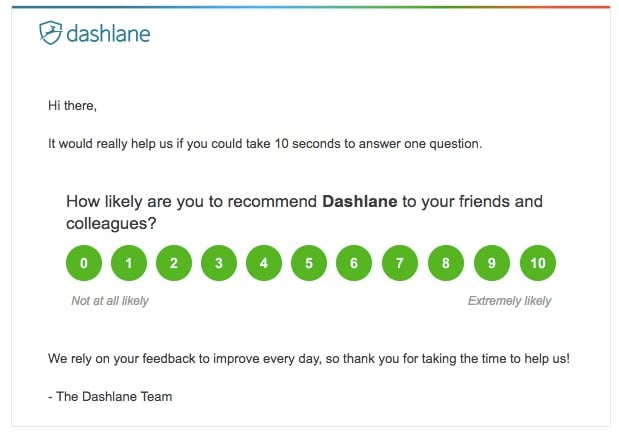

Dashlane‘s email
This method is applicable when you are looking for ways to improve customer satisfaction.
NPS is simple and has a one-click design.
But remember, that you need a big customer base of a certain size to make survey results reliable.
Pro Tip: Differentiate your website visitors and show them targeted NPS surveys.
4. Ask for feedback on the thank-you page
Your thank-you page which comes after the order confirmation is an ideal place for seeking customer feedback.
It’s a great moment to ask questions like:
– ‘Were there difficulties in navigating the website?’
– ‘Was it easy to find the desired product or category?’
– ‘Were you satisfied with the options available?’ and so on.
Keep the questions multiple-choice, as short as possible, and feature a general text box for other comments.
5. Ask for feedback when prospects abandon their carts
All and their moms know that e-commerce websites face an enormous abandonment rate of approximately 70 percent.
Unfortunately, other businesses too well know the situation when a prospect is about to pay but instead of clicking the ‘Pay Now’ button… they close the window.
Customer feedback survey at this stage plays a crucial role in improving the conversion rate and growing revenue.
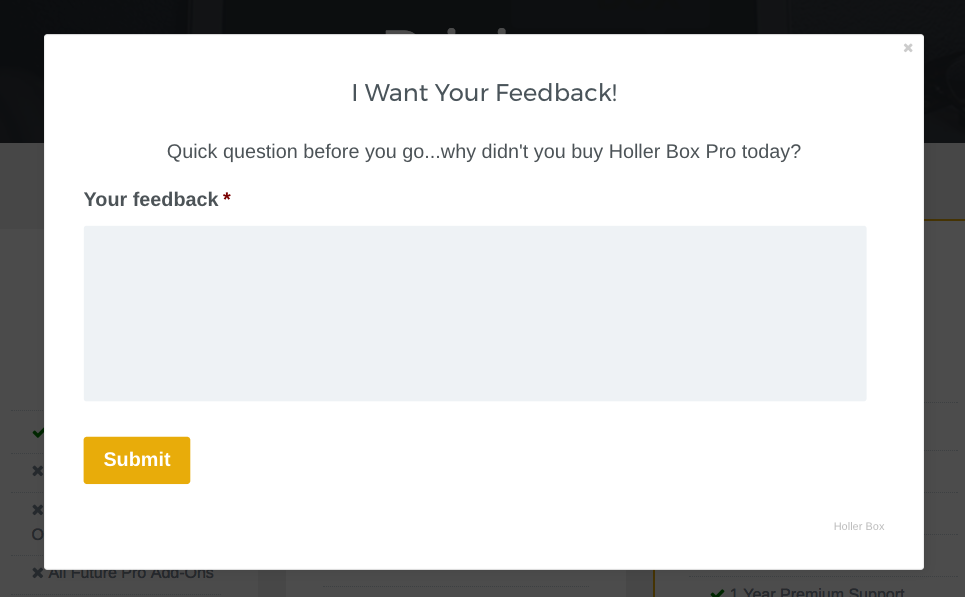

Showcase a small and sweet popup with a short text box and ask prospects to explain why they have not proceeded to the checkout.
Also, you can give them canned reasons for abandonment like ‘A better deal at another website’, ‘Bad delivery options’, etc.
What’s more, right in a pop-up, provide the prospect with an option to contact customer service.
6. Send feedback emails for new clients
Email marketing is a great method of gathering information on the entire client experience. Post-purchase emails are a must-have when it comes to new shoppers.
Send out a post-purchase survey within 10 minutes or three days (depending on the type of your services) after order confirmation. Use tools like SurveyMonkey to reach out to new customers.
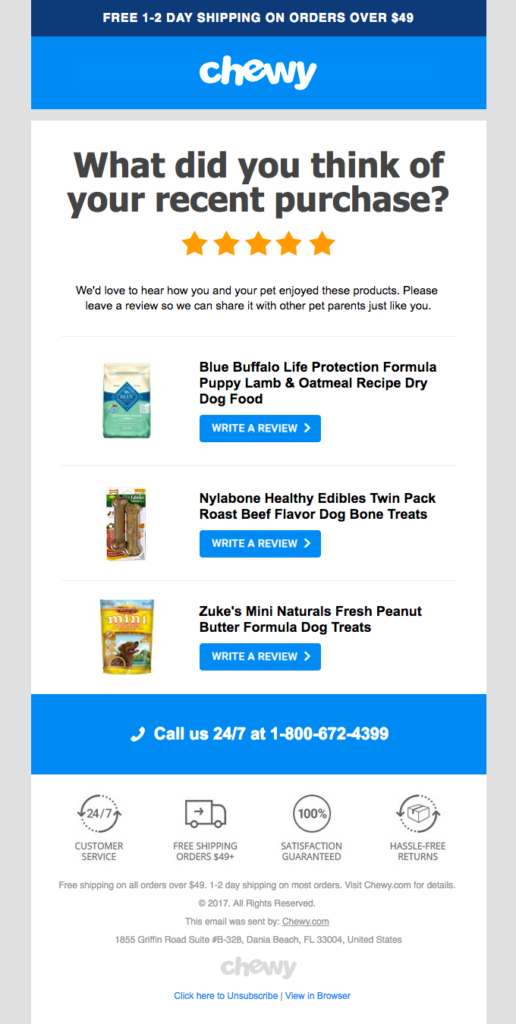

Chewy’s emails sent to new customers
Another convenient and automated way to collect feedback is by using a testimonial and review platform like Trust.
This tool gathers and displays your testimonials – all you have to do is approve them and they’re on your site.
The process here is quite simple:
1) Customer purchases the product and immediately receives a link,
2) They leave their feedback and Trust works on the data
3) You approve the testimonial and it goes live on your website.
Here you can get feedback about the motivation for choosing you among the competitors (price? features? free delivery? first position in the Google search results?).
Also, ask how customers have found you (Google? friends’ testimonials? social media? review resources?). Needless to say it’s a good moment to get feedback on your product or service).
The only thing to remember is that this email is dedicated to customer experience and satisfaction. Resist the urge to feature here crass-sale offers.
7. Use transactional emails to gather customer feedback
Transactional emails are used when a user or customer commits certain actions: sign up for a service, move to the paid plan from the trial tier, upgrade to a new plan, etc.
In a nutshell, these emails are triggered while the interaction between the user and your app takes place.


Uber’s transactional email
Transactional emails can foster a dialogue with users and customers.
Asking the right questions in these emails will certainly help you get quality feedback.
Considering that, include a quick one-liner question or a short multiple-choice question in your next transactional email.
8. Monitor social media
Social media is an invaluable resource for customer feedback and so-called ‘social listening’.
An ocean of tools like HootSuite is ready to gather mentions and conversations about your company on social media as well as monitor the social presence of your business rivals.
Social listening provides a great opportunity to get quality customer feedback and respond to any issue that might arise in the blink of an eye.
9. Monitor customer feedback on other resources
Q&A websites and review catalogs are excellent sources of feedback in addition to various online communities, blogs, local listings, etc.
It’s a good idea here to adopt tools that track mentions and conversations about your brand. A free and handy solution for beginners is Google Alerts.
This tool not only lets you monitor reviews about your company but also provides information on customer feedback about business rivals.
10. Gather in-app feedback
If you have a business app, you are a lucky researcher – in-app customer feedback gives you numerous important insights on how your prospects or customers actually use your service or product.
First, you can gather application usage statistics with advanced analytics tools like Intercom and Segment.
Sure, these tools won’t give you direct answers, but you will definitely discover growth points for your business.
Second, having an app, conduct short in-app surveys to gather quality customer feedback.
It’s a good idea here to segment users into groups like ‘users who visited the app more than five days’ and engage them with the targeted message.
Also, a survey can show up when a user is interacting with a particular feature in the app.


Mopinion’s in-app feedback
Why do they use your app rarely? Why do they resist upgrading or purchasing the paid tier?
Do they understand the value of your new feature? These and many other crucial questions you can answer with the help of in-app surveys.
11. Analyze on-site activity
Website analytics tools like Google Analytics allow learning a lot about your prospective clients without actually asking them.
For instance, if your particular page has a bad bounce rate and website visitors spend about five seconds there, it’s obvious even without feedback surveys that this page is absolutely useless.
Also, Google Analytics provides you with data on keywords website visitors search on your website. Knowing them, you can improve clients’ self-service experience.
The heatmap tools like HotJar let you learn why people don’t convert on certain landing pages.
For instance, check how many new users have viewed features, how many of them have moved to the pricing page then, and who of them have signed up eventually.
If you see this path, you can understand at which moment you lose your prospective clients.
12. Use the forum to get in touch with prospects
When it comes to the software industry, forums are a great way to discover what prospects and clients think about your products as well as interact regularly with them.
Bet remember that you have to maintain and moderate your forum because a deserted forum looks exactly like an abandoned social media profile.
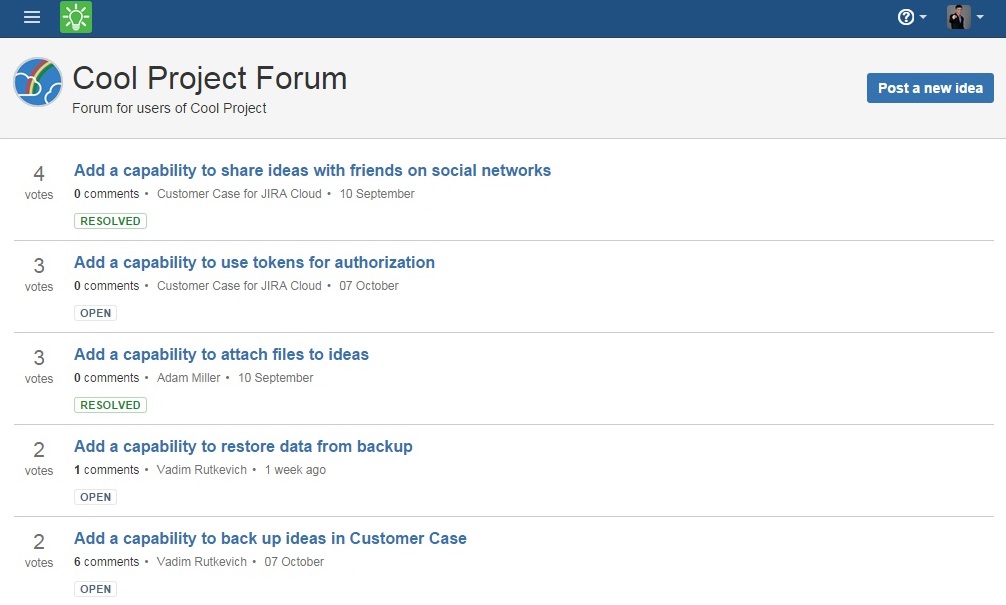

Suggestion boards, available in the forum, are a great way to get customer feedback.
These boards allow users to collaborate on ideas on how to improve your product.
Also, using suggesting boards, users can create feedback posts that can be upvoted by other users. Highly upvoted or commented boards can help you discover what the major users’ needs and challenges.
13. Add feedback surveys to your Wi-Fi network
If you have any offline business location like a cafe, shop, or bar and provide free Wi-Fi, this gives you valuable opportunities to gain customer feedback.
Request people to create a free account to access the network and then use the captured email address to ask for feedback.
Alternatively, you can simply show up a pop-up to ask about their experience while they’re online.
14. Conduct customer interviews
If you think that interviewing customers is a prerogative of large corporations, you are wrong.
Loyal customers are likely to give quality feedback if you simply ask them.
At the end of the day, they’re interested in your product or service evolution.
Done right, customer interviews uncover a lot of useful things for your business growth.
While preparing for a customer interview, follow a few no-brainer ground rules.
First, segment your customer base and focus on those who are the most interesting to you. Second, keep the questions short.
Next, adjust your questionnaire after interviews to find the best wording for the questions.
15. Call your customers regularly
Calls are probably the most personalized way to get customer feedback.
The only thing to remember here: resist the urge to sell during these calls!
Instead, strive to help and benefit the client. Ultimately, calls should strengthen your relationships with customers and make them feel valued.
Pro Tip: This method of getting quality feedback is very effort-intensive, especially for clients. Considering that, choose loyal customers with a long-standing relationship between them and your company.
Best practices while asking for feedback
Let’s be honest: it may be difficult to acquire quality customer feedback.
Although clients are more likely to spread negative testimonials, they don’t hurry up to provide you with positive reviews. It’s your job to make it possible.
Here we are prepared a few sure-fire ways to increase your odds:
– Ask for feedback in return for an incentive
Motivate your clients to leave feedback by offering them some gifts (free shipping, small discounts on future purchases, Amazon gift cards, etc.).
Make the prize valuable for the customer, not just adopt a cross-sell tactic. Also, you can offer free content that may be useful to clients’ workflow (e-book, in-house study, etc).
The “Thank you” page in a survey by Trust
– Seek feedback right after purchase
You have the best chance to get quality feedback right after the purchase.
Display a popup after the purchase completion.
– Keep your survey questions extremely short, sweet, and simple
Keep the number of questions low and try to use multiple-choice questions. Meanwhile, phrase your survey questions in such a way that the replies are more likely to give you useful insights.
And inject humor into your feedback question where possible. Nobody likes dry-as-dust surveys.
– Minimize customer effort
Make life easier for everyone involved by giving preferences to online surveys.
Enable customers to answer questions with just a few clicks.
What’s more, the analysis of online data will be far simpler for you.
How to use customer feedback?
Let’s imagine that you have already got a few testimonials using the above-mentioned recommendations.
Now it’s time for the next stage: make use of quality customer feedback.
Sometimes companies don’t benefit from gathering clients’ opinions at full capacity.
First, you should take a deep look at the feedback, categorize it, and share it with your product team or your customer support center.
Then, here are a few ways you can benefit from streamlined clients’ feedback:
1. Display positive testimonials
Displaying customer feedback is a powerful marketing technique called ‘social proof’.
Social proof featured on your website has numerous advantages. First, it’s recognition for the customers who have left reviews.
What’s more, social proof encourages other prospects to trust your company and convert. Customer testimonial platforms like Trust automatically gather and display your testimonials as notification popups, widgets, or a rating badge.
2. Use negative reviews to demonstrate your problem-solving skills
Even the worst testimonial can be used to your advantage.
Start by responding respectfully. From there, try to contact the unsatisfied customer directly and solve his problem. If it’s not possible, apologizing is always a wise choice.
3. Translate feedback into product innovation
Use customer feedback to drive product and service improvements for your company.
Since clients use your products daily, they may have ideas you haven’t considered. Thus, quality feedback is the shortest way to identify customers’ needs that haven’t been solved.
4. Spread the word about your business
Encourage customers to share online testimonials via social media. In exchange, offer them a small sweet incentive.
5. Prevent customer churn
Don’t be afraid of negative feedback.
It is a great opportunity to prevent customer churn and foster a long-term relationship with them.
Just reach out to them and try to understand their issues. It’s your job to show that you truly care and do your best to make them happy.
Wrapping up
Getting quality customer feedback is important for every company because it’s the best way to improve your services and customer experience.
Luckily, there is an ocean of methods you can use to generate feedback.
In this article, we have put together 15 different techniques to know your clients better, from simple pop-up surveys to analyzing inexplicable customers’ signals.
Which of the above-mentioned methods of gathering feedback have you tested out? Which one was not mentioned in the article?



